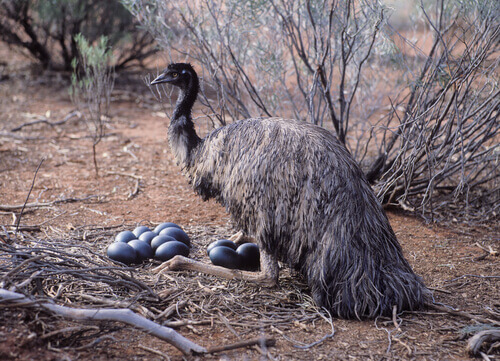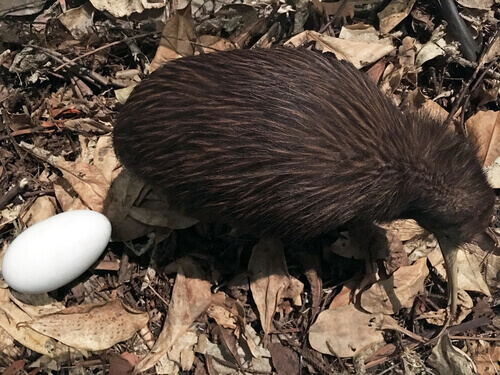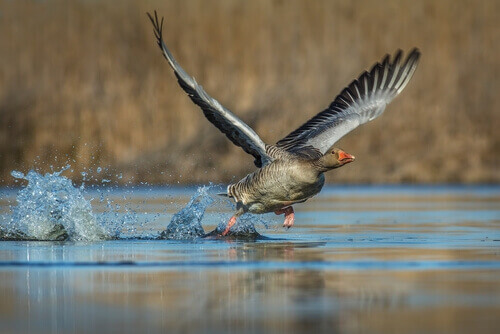The Largest Bird Eggs in the Animal Kingdom

An ostrich isn’t the same size as a sparrow… not even at birth! Therefore, baby ostriches–and other large birds–need a place to develop according to their needs. In this article, we’ll tell you all about the largest bird eggs that exist in the animal kingdom.
What are the largest bird eggs?
To get an idea of which the largest bird eggs are, we can analyze the size of the species when they reach adulthood. In most cases, this ‘rule’ works. Here are some of them:
1. Ostrich
The ostrich, which appears in the cover photo of this article, is one of the largest birds in existence. Not only that, its eggs are the largest in the animal kingdom. In fact, they can measure almost 10 inches and weigh almost 2.5 pounds! To give you an idea of its dimensions, it’s equivalent to two dozen chicken eggs.
These eggs are white and light yellow, a characteristic that prevents them from being overheated by the sun or the high temperatures of the savannahs where they live. When the chicks are born, they are already quite big, and the father is in charge of taking care of them.
2. Emu
A direct relative of the ostrich, this large bird–which doesn’t fly–lives in Oceania and its plumage is dark gray. Until a century ago, it was very common to spot these animals. However, their population has decreased quite a lot.

One interesting fact in relation to the eggs of this species is that they’re dark green. And, of course, they’re large–almost like those of their close relatives, the ostrich.
Another similar characteristic is that the male is in charge of covering them and taking care of the chicks when they’re born. This is because he can have several females at the same time. In that sense, fathers are then responsible for ‘looking after’ all the siblings, even if they’re from different mothers.
3. Kiwi
Although this New Zealand endemic bird is small in size, the female lays eggs that can be 5.5 inches high and 3.5 inches in diameter.

4. Northern cassowary
This species of bird, related to ostriches, is native to Papua Guinea. It lives in tropical forests and is a large animal with long, thin legs and bright blue colors on the neck and head.

5. Goose
This bird, native to Eurasia and North Africa–and domesticated in several parts of the world–lays eggs three times larger than those of chickens. The common goose is the largest of the duck family and possesses a robust body, pink legs and beak, and brownish-gray plumage with darker areas.

An ostrich isn’t the same size as a sparrow… not even at birth! Therefore, baby ostriches–and other large birds–need a place to develop according to their needs. In this article, we’ll tell you all about the largest bird eggs that exist in the animal kingdom.
What are the largest bird eggs?
To get an idea of which the largest bird eggs are, we can analyze the size of the species when they reach adulthood. In most cases, this ‘rule’ works. Here are some of them:
1. Ostrich
The ostrich, which appears in the cover photo of this article, is one of the largest birds in existence. Not only that, its eggs are the largest in the animal kingdom. In fact, they can measure almost 10 inches and weigh almost 2.5 pounds! To give you an idea of its dimensions, it’s equivalent to two dozen chicken eggs.
These eggs are white and light yellow, a characteristic that prevents them from being overheated by the sun or the high temperatures of the savannahs where they live. When the chicks are born, they are already quite big, and the father is in charge of taking care of them.
2. Emu
A direct relative of the ostrich, this large bird–which doesn’t fly–lives in Oceania and its plumage is dark gray. Until a century ago, it was very common to spot these animals. However, their population has decreased quite a lot.

One interesting fact in relation to the eggs of this species is that they’re dark green. And, of course, they’re large–almost like those of their close relatives, the ostrich.
Another similar characteristic is that the male is in charge of covering them and taking care of the chicks when they’re born. This is because he can have several females at the same time. In that sense, fathers are then responsible for ‘looking after’ all the siblings, even if they’re from different mothers.
3. Kiwi
Although this New Zealand endemic bird is small in size, the female lays eggs that can be 5.5 inches high and 3.5 inches in diameter.

4. Northern cassowary
This species of bird, related to ostriches, is native to Papua Guinea. It lives in tropical forests and is a large animal with long, thin legs and bright blue colors on the neck and head.

5. Goose
This bird, native to Eurasia and North Africa–and domesticated in several parts of the world–lays eggs three times larger than those of chickens. The common goose is the largest of the duck family and possesses a robust body, pink legs and beak, and brownish-gray plumage with darker areas.

This text is provided for informational purposes only and does not replace consultation with a professional. If in doubt, consult your specialist.








